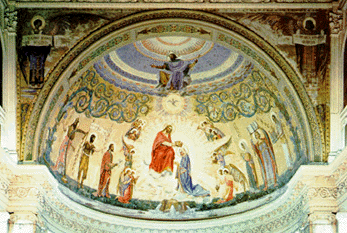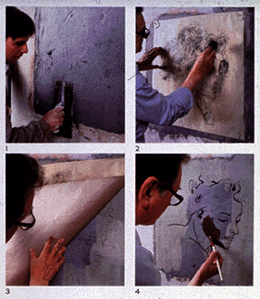|
Technique |
||
|
Some of Nincheri's painting is described in the section called Decoration,
but on this website Fresco is a separate category to emphasize that it is
quite distinct from other kinds of painting. Unlike oil painting or tempera
which is painted on a surface support like canvas or wood panel, fresco
painting becomes a permanent part of the surface through chemical bonding
of pigments with freshly laid plaster. The colours integrate with the surface
as it dries and the finished picture is inseparable from the actual wall
or ceiling.
An accomplished artist, Guido Nincheri was instrumental in introducing to North America fresco techniques like those used by Michelangelo in the sixteenth century. Important frescoes by Nincheri can still be seen in St Ann's Church in Woonsocket, Rhode Island (c.1941-c.1949) and at Ste. Amélie in Baie-Comeau, Quebec (1939). One of Nincheri's frescoes is over the main altar of St. Theresa of the Child Jesus in Ottawa, Ontario. Among those you can see in Montréal are the ones in St. Michael's and St. Anthony's (1927) and the Chapel of the Saints-Noms-de-Jésus-et-de-Marie Mother House (1926) shown here. Those in the churches of St-Léon-de-Westmount (c.1920) and Notre-Dame-de-la-Défense (c.1933) are described in more detail here on this website. The fresco painter needs skill and confidence to work rapidly without errors. Fresco is an unforgiving medium that does not allow touch-ups. Correcting a mistake could involve chipping two layers of plaster off the wall. Fresco techniques have been used throughout the ages in many different places ranging from sixth century religious cave paintings in Ajanta, India to modern political murals popular in Mexico and the United States during Nincheri's lifetime. The following is a brief description of the traditonal Tuscan Renaissance method of fresco painting. To guide the final painting it is necessary first to make drawings or paintings in full colour including a full-scale drawing (called the Cartoon) of the exact size to be transferred to the wall or ceiling. The surface of the wall is prepared with several layers of increasingly finely textured plaster. Multiple coats of plaster add strength and are a safeguard against cracking. Each layer must cure for several days before the next is added. The final layer, or Intonaco, is laid each day when the painting starts. The colours, or Mestiche, are prepared by mixing finely ground pigment (mostly earth colours) in distilled water or in lime water. Because lime is a caustic alkalai and certain colours (such as azure and ultramarine) break down when exposed to it, they have to be added à secco over an undercoat after the fresco dries. Working from the artist's drawings and paintings the Sinopia, or sketch of the final composition covering the entire area of the fresco is brushed on to the Arriccio, or next to last layer of plaster. This provides a guide to show where the Giornata will be traced each day from the Cartoon. Giornate are areas that can be painted in one session. At last the fresco painter is ready to begin. The Cartoon is cut up into pieces suitable for the Giornate. The Intonaco is thinly applied in an area that can be completed in one session and it is smoothed with a trowel. When the fresh plaster is firm enough the design from the piece of the Cartoon belonging to that area is transferred to the wall by pouncing or it is incised with a stylus. About two or three hours after the plaster has been laid, water brushed on the wall should be directly absorbed instead of resting on the surface. Then the surface is ready. Painting can begin and continue for a few hours until the surface no longer absorbs the pigment. Colour applied after the plaster is set will not adhere. To match each day's work to completed parts and control the painting's ultimate appearance the artist must know what will happen to the colours as they are absorbed, drying and changing day by day as the plaster cures. Paint is applied with 15 to 20 minutes between glazes, to allow crystallization to lock in each layer. Corrections cannot be made. At the end of the day's work unpainted plaster and mistakes are cut away. Clearly fresco is a painstakingly labour-intensive technique. Yet it results in painting with a special character derived from the rapid application of the colour and the glossy crystalline finish of the calcium carbonate on the surface of the plaster. |
|
 Photo: Studio O. Allard Photographes Inc. Chapel of Saints-Noms-de-Jésus-et-de-Marie Motherhouse Courtesy of des soeurs Saints-Noms-de-Jésus-et-de-Marie 
|
The art of Guido Nincheri 1999
[Welcome]
[Biography] [Stained
Glass] [Fresco] [Decorations]
[collections]
[glossaries]
[church list] [bibliography]
[team/credits]